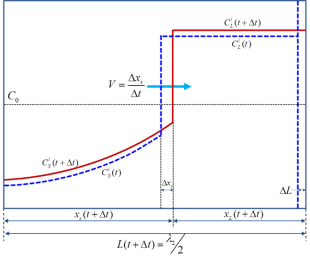Numerical Model
The PanSolidification module, which is developed by coupling a solidification micro-model with PanEngine, is basically a modified Scheil model incorporating back-diffusion, undercooling, and dendrite arm coarsening. Figure 1 shows a sketch of dendrite, with a big solid trunk as the primary dendrite arm and fine secondary dendrite arms symmetrically distributed at the sides; the SDAS is indicated as λ2. A one-dimensional morphology within the interdendritic region of secondary arms is usually used to describe the solidification processing (as enlarged and shown at the bottom part of Figure 1. Because of the symmetry of the dendrite arms, there is no mass flow through the arm center. Therefore, only half of the arm spacing is considered.
Back Diffusion in the Solid
The evolution of the concentration profile for component i in the considered dendrite arm is shown schematically in Figure 2.
Figure 2: A schematic plot showing the composition distribution of component i in a dendrite arm at time t and t+Δt
and
are compositions of component i within the liquid and solid phases (given the unit of wt.% in this work), respectively. V is the velocity of S/L interface. During the time interval Δt, the S/L interface advances Δxs (due to solidification) and the length of the solidification region increases by ΔL (due to the SDAS coarsening). For the current solidification simulation at each time step, three major tasks are carried out: (1) calculate the composition of each component at the S/L interface including the undercooling effects and local-equilibrium conditions; (2) solve the diffusion equations within the solid phase; (3) update the length scale to conserve mass balance for every component. More detailed description on the back diffusion can be found in some textbooks [1974Fle, 1985Kur].
Micro-Model for Dendrite Arm Coarsening
The initial SDAS is about twice of the dendrite tip radius: and
is described as a function of initial alloy composition, growth rate, and independent of temperature gradient:
|
|
where V, ΔT0, ke are the interface solidification velocity, freezing temperature range, and equilibrium partition coefficient, respectively. δ is a constant being dependent on the harmonic of the perturbation.
The dendrite arm spacing needs to be known since it sets the diffusion distances in the liquid and solid phases. Owing to the re-melting and re-solidification mechanism, dendrite arm coarsening contributes significantly to homogenization during solidification. The calculation of coarsening is described as below [1986Roo]:
|
|
(2) |
is the initial SDAS obtained from the calculated dendrite tip radius as described in above Eq. 1, and
is the model predicted SDAS at a certain time. M is coarsening parameter which is proportional to
, t is time and g is the geometry factor representing the influence of the dendrite geometry.
For a binary system, the coarsening parameter M is defined as [1990Roo]:
|
|
For a multi-component system, the coarsening parameter must be calculated separately for each alloying element. Then, the following model is used to take into consideration all the solute elements:
|
|
(4) |
All phase equilibrium related quantities needed in the above equations (such as mL and ke) are directly calculated via PanEngine [2009Cao] at each time step by assuming the local equilibrium at the liquid/solid interface.
references:
[1974Fle] M.C. Flemings, Solidification Processing, McGraw-Hill, 1974.
[1985Kur] W. Kurz and D.J. Fisher, Fundamentals of Solidification, Trans Tech Publications, Switzerland, 1985.
[1986Roo] A. Roósz, E. Halder, and H.E. Exner. “Numerical calculation of microsegregation in coarsened dendritic microstructures”, Mater. Sci. & Tech. 2 (1986): 1149–1155.
[1990Roo] A. Roósz, H.E. Exner, “Numerical modelling of dendritic solidification in aluminium-rich Al-Cu-Mg alloys”, Acta Metall. Mater., 38 (1990): 375-380.
[2009Cao] W.S. Cao et al., “PANDAT software with PanEngine, PanOptimizer and PanPrecipitation for multi-component phase diagram calculation and materials property simulation”, Calphad, 33 (2009): 328-342.

